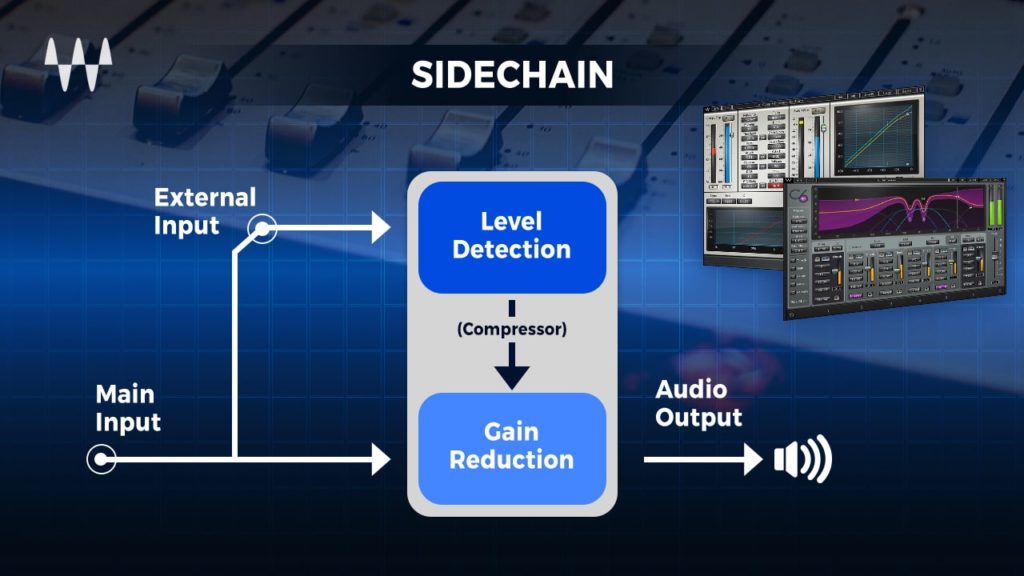
Sidechain compression is a technique used in music production to control the volume of one track based on the level of another. In simpler terms, it is a way to make one instrument or sound “duck” or lower in volume when another sound is playing, creating a more dynamic and balanced mix.

Sidechain Compression
To understand how sidechain compression works, it’s helpful to know how a compressor works in general. A compressor is an audio processing tool that reduces the dynamic range of a sound. This means it reduces the difference between the loudest and quietest parts of the sound, making it sound more consistent and controlled. When a compressor is applied to a track, it lowers the volume of any part of the sound that exceeds a certain threshold level. This threshold level is set by the user, and the amount of reduction is determined by the ratio control.
In sidechain compression, the compressor is triggered by a separate audio source, rather than the track it’s applied to. This separate audio source is called the sidechain signal. The compressor is set up to listen to the level of the sidechain signal, and whenever the level of the sidechain signal exceeds the threshold level, the compressor reduces the volume of the main track.
One common use of sidechain compression is to make room for a kick drum in a busy mix. In this scenario, a compressor is applied to a pad or synth that’s playing throughout the song, and the sidechain signal is taken from the kick drum. The threshold level is set so that whenever the kick drum plays, the volume of the pad or synth is reduced, creating space for the kick drum to be heard. When the kick drum stops playing, the volume of the pad or synth returns to normal.
Another common use of sidechain compression is to create a pumping effect in dance music. In this case, the sidechain signal is often a low-frequency oscillator (LFO) that’s synced to the tempo of the song. The compressor is set up so that whenever the LFO reaches its peak, the volume of the main track is reduced, and when the LFO reaches its trough, the volume of the main track returns to normal. This creates a rhythmic pumping effect that’s popular in many dance genres.
Sidechain compression can also be used for more subtle dynamic control, such as to create space for a lead vocal or to tame the transients of a snare drum. It’s a powerful tool that can add a lot of depth and movement to a mix when used effectively.
It’s important to note that sidechain compression is not a one-size-fits-all solution. The amount of reduction, the attack and release times, and the ratio control all need to be carefully adjusted to fit the specific needs of the mix. Additionally, sidechain compression can be overused, leading to a mix that sounds unnatural or gimmicky. As with any audio processing tool, it’s important to use sidechain compression judiciously and with intention.
In summary, sidechain compression is a technique used in music production to control the volume of one track based on the level of another. It’s a powerful tool that can create space and movement in a mix, and it’s commonly used to make room for a kick drum, create a pumping effect, or tame the transients of a sound. It’s important to use sidechain compression with intention and to adjust the settings to fit the specific needs of the mix.
Read more about Mixing in the book “The Mixing Engineer’s Handbook 4th Edition“
Guest Engineer Interviews
FOH Engineer Garry Brown (Phish, Trey Anastasio Band, Oysterhead)
Behind the Live Sound of Coldplay with Daniel Green
Red Hot Chili Peppers Sound Engineer – Dave Rat 2016 Set up
Antony King – Front of House Engineer for Depeche Mode
Gavin Tempany – FOH Tame Impala, Mark Knopfler, Hans Zimmer, Kylie and Eskimo Joe
Analogue vs Digital, How to ‘Hear’ when Mixing with Andrew Scheps
Matthew Walsh FOH Audio Engineer War on Drugs
Bob Strakele Interview – FOH Audio Engineer Slipknot
